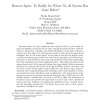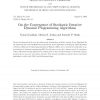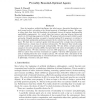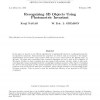102
Voted
CORR
1998
Springer
15 years 13 days ago
1998
Springer
An important characteristic of many logics for Arti cial Intelligence is their nonmonotonicity. This means that adding a formula to the premises can invalidate some of the consequ...
125
Voted
AI
1998
Springer
15 years 14 days ago
1998
Springer
Renewed motives for space exploration have inspired NASA to work toward the goal of establishing a virtual presence in space, through heterogeneous eets of robotic explorers. Info...
104
Voted
NIPS
1993
15 years 2 months ago
1993
Recent developments in the area of reinforcement learning have yielded a number of new algorithms for the prediction and control of Markovian environments. These algorithms,includ...
91
Voted
IJCAI
1993
15 years 2 months ago
1993
Since its inception, arti cial intelligence has relied upon a theoretical foundation centred around perfect rationality as the desired property of intelligent systems. We argue, a...
108
Voted
AAAI
1994
15 years 2 months ago
1994
Researchers in the eld of Distributed Arti cial Intelligence (DAI) have been developing e cient mechanisms to coordinate the activities of multiple autonomous agents. The need for...
109
Voted
ICCV
1995
IEEE
15 years 4 months ago
1995
IEEE
In this paper we describe a new e cient algorithm for recognizing 3D objects by combining photometric and geometric invariants. Some photometric properties are derived, that are i...
118
Voted
ECAL
1995
Springer
15 years 4 months ago
1995
Springer
Neither `design' nor `evolutionary' approaches to building behavior-based robots feature a role for development in the genesis of behavioral organization. However, the n...
115
Voted
ECAI
1992
Springer
15 years 4 months ago
1992
Springer
Abstract. The paper refutes the general phenomenological argument that knowledge cannot be completely represented by symbols and, hence, symbolic AI does not work. Moreover, the vi...
105
Voted
ATAL
1997
Springer
15 years 5 months ago
1997
Springer
Abstract. We argue that none of the existing epistemic logics can adequately serve the needs of agent theories. We suggest a new concept of knowledge which generalizes both implici...
87
Voted
AGENTS
1997
Springer
15 years 5 months ago
1997
Springer
Recent developments in philosophy, linguistics, developmental psychology and arti cial intelligence make it possible to envision a developmental path for an arti cial agent, groun...





